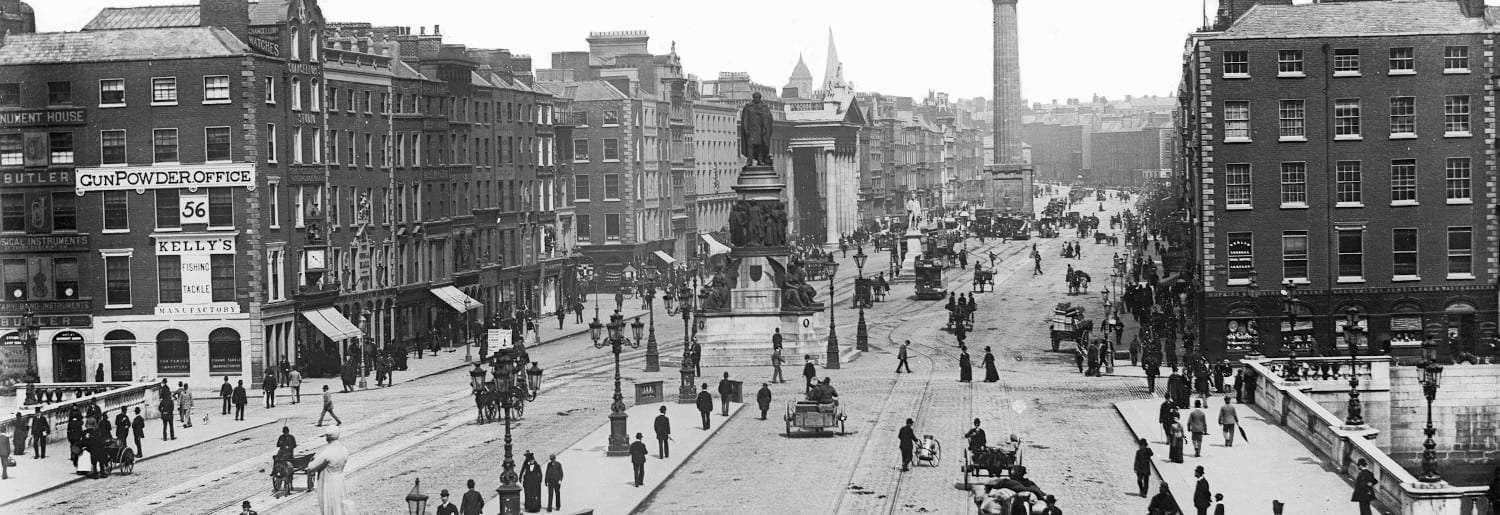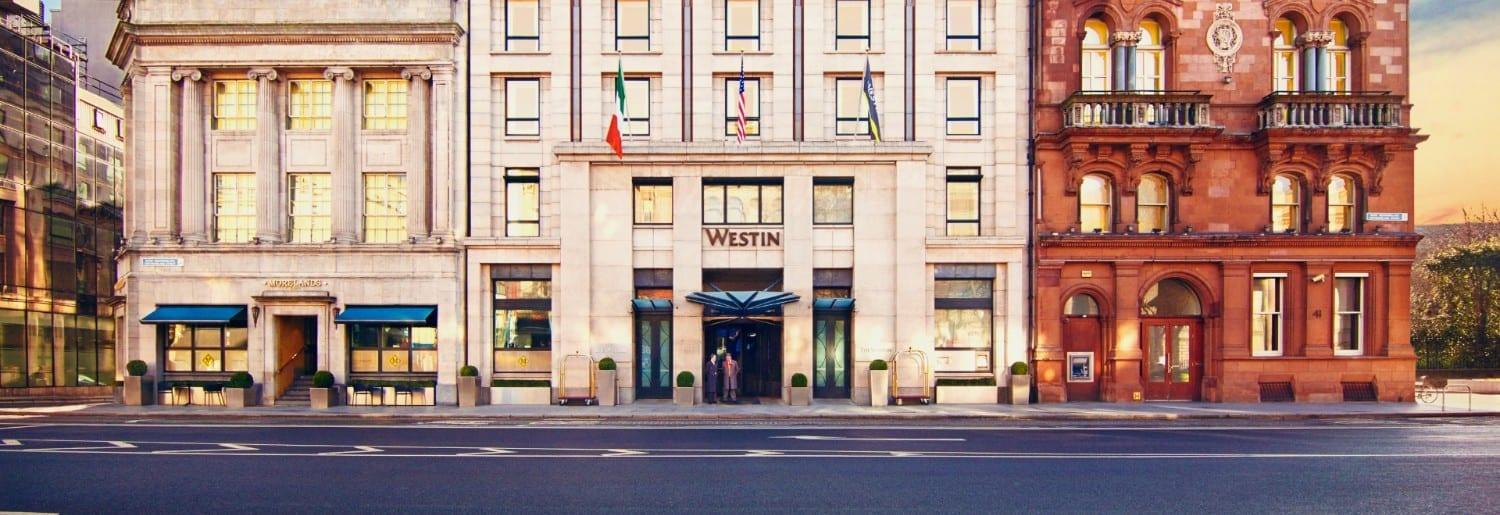As part of our series focusing on what makes Dublin City unique we’ve created a series on the history of the streets that make up the heart of the metropolis – and this edition takes a look at O’Connell Street.
The story of O’Connell Street takes us all the way back to Henry Moore, 3rd Earl of Drogheda who began developing north east of the lands of the former St. Mary’s Abbey. Moore was no shrinking violet and the areas developed carried his names which still survive today as Henry Street, Moore Street and (North) Earl Street. The street we now know as Upper O’Connell Street was known as Drogheda Streeet and unlike O’Connell Street today this street was primarily a narrower, residential one. However it only extended roughly half its current length as far as the present day location of the Spire.

Sackville Street, Dublin / Photo: Michael Angel Hayes (1853)
Things began to change with the arrival of Luke Gardiner who purchased much of the old Moore estates in north Dublin in around 1714. From the 1740s and 50s Gardiner began to develop these locations, his development of what we would consider to be Dublin’s first Georgian Street; Henrietta Street had been hugely successful and now Gardiner’s attention became focused on Drogheda Street. Much of the housing that was there was demolished and a range of fine Georgian townhouses were constructed in their place.
The street was also widened to its current size, which allowed the creation of a central mall for the new, wealthy citizens of the area to take their walks and display their finery. The name was also changed from Drogheda Street to Sackville Mall or Sackville Street, after the Lord Lieutenant Lionel Sackville, the Duke of Dorset. Dorset Street, which up until that point had been known as Drumcondra Lane, also had its name changed in honour of the Lord Lieutenant.

Lionel Sackville, 1st Duke of Dorset Lord Lieutenant of Ireland
Around this time just north of Sackville Street, a philanthropic surgeon named Bartholemew Mosse was laying out his pleasure gardens at what is now Parnell Square. These gardens were to help fund the construction of his revolutionary new Lying-in hospital, what we know today as the Rotunda. However, the exact layout of the hospital and the gardens may also owe something to Luke Gardiner who developed Cavendish Row and kept access from Sackville Street up to Dorset Street rather than have Sackville Street terminate at the entrance to new hospital and gardens.
It seems that Gardiner had similar ambitious plans for the lower end of Sackville Street, there were proposals in the Irish House of Commons from the late 1740s onwards to build a new bridge across the Liffey further downstream, which could connect Sackville Street to the south quays and make this the major north-south route across the Liffey rather than Essex Bridge, which linked Capel Street to the southside.

Sackville Street and Gardiner’s Mall, Dublin, circa 1760 / Photo: Oliver Grace
This new bridge wouldn’t come to pass for another 40 years however. It would be 1791 before construction would begin on the Carlisle Bridge, based on the design and plans of architect James Gandon. Now known simply as O’Connell Bridge (the Earl of Carlisle was yet another Lord Lieutenant) it was 1794 before the bridge opened – and this was a crucial moment in the development of the city. This new bridge shifted the economic axis of the city further to the east and also connected the vast Gardiner estate (then in control of the grandson of the original Luke Gardiner) on the north with Trinity College, the Houses of Parliament on College Green (now Bank of Ireland) as well as the likes of the Fitzwilliam estate on the south of the city.
In the lead up to the construction of the new bridge the planning body in the city, the Wide Streets Commission, obtained a financial grant from Parliament in order to widen the lower end of Sackville Street from 1777 onwards, this also allowed the expansion of the lower end of the street to the same dimensions as the upper end, for a time this was even called New Sackville Street.
These changes had a profound impact in the years after the bridge opened, the character of the street changed in the early 19th Century from residential to one with a greater focus on retail and services. Today all that survives of the Georgian mansions that once lined the street in the days of Luke Gardiner is number 42 O’Connell Street, located in the upper west side of the street and due to be preserved and incorporated into the new Hammerson development of the wider site.

Sackville Street, Dublin / Photo: Robert French of Lawrence Photographic Studios, National Library of Ireland on The Commons (1905)
Throughout the 19th Century these commercial changes became evident, primarily in the newer, lower end of Sackville Street. In 1814 construction began on the new General Post Office, designed by Irish architect Francis Johnston, it would open its doors to the public in January 1818. A year earlier Thomas Gresham had opened his first lodging house at 21-22 Sackville Street – more than 200 years later the Gresham Hotel is still operating on the same street.
By the middle of the century McSwiney, Delaney & Co. had opened their “Palatial” or “Monster” Mart, effectively one of the city’s earliest purpose built department stores, it would be purchased in the 1880s by M.J. Clery and become known from then on as Clery’s. The Metropole Hotel opened on a site occupied today by Penneys while Finlater’s wine merchants opened a sizeable premises at the corner now taken by the Holiday Inn.

General Post Office and Nelson Pillar / Photo: H. Fisher, son, and Jackson (1830)
At the centre of the street rising 134 feet above the ground stood a statue of Admiral Horatio Nelson, the hero of the British Navy who had died at the Battle of Trafalgar in 1805. Within weeks of that event Dublin Corporation had suggested the erection of a statue commemorating the late Admiral and by 1809 the huge pillar, topped by Nelson’s thirteen foot high statue had been completed. The spiral stairway of 168 steps that wound its way through the centre of the column let to a viewing platform immediately beneath the statue, and gave the ordinary Dubliner probably the finest view of their city for more than 150 years.
The pillar quickly became a tourist attraction and as the city developed became a focal point for the capital’s rapidly expanding tram network, several of the city’s 31 different tramlines passed of terminated at the pillar, making Sackville Street, and later O’Connell Street a transport hub.

General Post Office, Dublin / Photo: British Library (1837)

O’Connell Bridge and Sackville Street, Dublin / Photo: National Library of Ireland on The Commons (1890)
Of course the pillar was not universally popular, the presence of a British Admiral looking over the city struck a sour note for many and there were calls almost since its construction for the statue to be replaced. This growing nationalism can be seen by the fact that as early as 1884 there were attempts to have Sackville Street renamed to O’Connell Street in honour of Daniel O’Connell, but this was blocked from officially taking place by local residents. It would be 1924 before the street would officially be rechristened O’Connell Street.
Towards the end of the 19th Century testament to the popularity and success of the street could be seen by the fact that O’Connell Bridge needed to be widened to meet the demands of the number of trams, carriages and pedestrians travelling across the Liffey. Work to widen the bridge began in 1877 and it reopened in 1882, coinciding with the unveiling of a new monument to Daniel O’Connell at the lower end of O’Connell Street. O’Connell Bridge is unusual in that because of these works it is now wider than it is long.

View from top of Nelson’s Pillar, Sackville Street, Dublin, circa 1921 / Photo: National Library of Ireland
By the early 20th Century the character of the street had changed further, cinemas and theatres were opening on, or adjacent to O’Connell Street, the Metropole and Clery’s were famous for their ballrooms and there were growing numbers of cafés and ice cream parlours. Of course the street endured several years of violent upheaval, which left a heavy mark. In September 1913 there were violent altercations between members of the Dublin Metropolitan Police and striking tram workers, two of the strikers were killed and more than 300 were injured.
It was however, the events of the 1916 Easter Rising that are most closely associated with the street after Pádraig Pearse read out the Proclamation of the Republic in front of the GPO. Easter week saw looting, death and destruction in much of the area of the city. The rebels had assumed that the British would not shell the centres of administration and commerce around O’Connell Street but they were sorely mistaken.
Gun positions on the south quays and the gun boat Helga shelled much of the area causing massive damage, which set off a series of fires. One witness statement describes the plate glass windows of Clery’s melting and running like lava down the street. When the fighting was done much of the street was in ruins and the insurance maps and photographs of the time show the scale of the devastation.

Abbey Street and Sackville Street, Dublin, May 1916 / Photo: Keogh Brothers Ltd., National Library of Ireland on The Commons

Sackville Street, Dublin, post-1916 Easter Rising / Photo: Miller, James Martin & H.S. Canfield
One of the few areas to avoid significant damage was the upper east side of the street but only a few years later this stretch of the street was seriously damaged during the “Battle for Dublin” that took place in the summer of 1922 a part of the Irish Civil War. As a result many of the older buildings we know on the street date from a period of reconstruction that began in the mid to late 1920s.

O’Connell Bridge, Dublin circa 1928 / Photo: Eason Photographic Collection
While it might have been assumed that the end of the Civil War, and an associated bombing campaign that had targeted cinemas and theatres on, or near to O’Connell Street, would lead to and end of destruction in the vicinity this wasn’t to be the case.
Very early on the morning of Tuesday, March 8th 1966 Nelson’s Pillar was destroyed by a powerful explosion that thankfully did not injure any members of the public, but did damage some surrounding buildings. Some accounts report that the Irish President, Éamon de Valera, phoned The Irish Press and suggested the headline: “British Admiral Leaves Dublin By Air” after news of the pillars destruction became known.

A half-demolished Nelson’s Pillar on O’Connell Street, Dublin / Photo: The Irish Times, 8 March 1966
Various replacements for the pillar were suggested, and rejected, over the years. In 1988 to celebrate the Dublin “Millennium” the Anne Livia statue and fountain were unveiled close to the site of the pillar, though it received the dubious nickname of the “Floozie in the jacuzzi” and was relocated in 2001 to make way for the installation of the 120 metre tall Spire of Dublin, which now stands on the old site of the pillar.
The Spire was completed by 2003 and by that stage a wider set of works had begun by Dublin City Council to improve the public space around the street; replacing and widening footpaths, installing new lighting and trees, while planning controls were introduced with the intention of protecting the buildings and commercial uses on the street.

Photo: Robert Linsdell
In 2017 trams returned to the street with the extension of the Luas Green Line with now two Luas stops at either end of O’Connell Street. There remain many historic businesses on the street that have been trading for over a century, such as Eason, McDowell’s Jewellers, The Gresham Hotel, even the Bank of Ireland have had a branch on the street for over a century. While there are also plans for the area around the old Carlton cinema to be redeveloped in the coming years.
The events of the 20th Century have shaped not only the physical street but have also shaped its uses. O’Connell Street had been a focal point for gatherings and ceremonial events long before the lock-out or the 1916 Rising but these events thrust the street into the public consciousness with imbued the street with a great social significance. The street now hosts parades, commemorations, celebrations marches and protests, it has become a focal point not just for Dublin but for the entire nation.

Photo: Shutterstock/Edward Haylan



